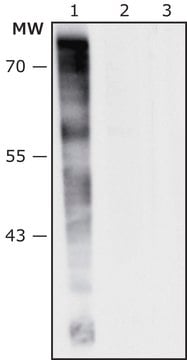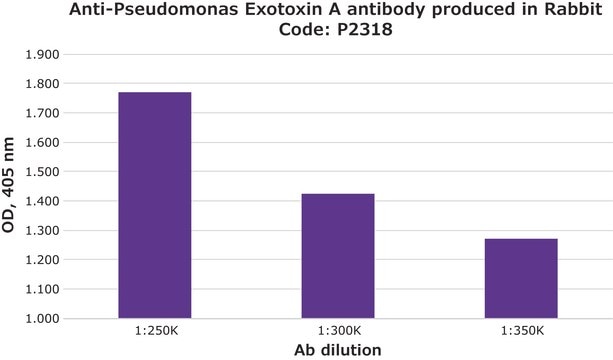General description
Pseudomonas aeruginosa is a rod shaped, gram negative, monoflagellated, aerobic to facultative anaerobe bacteria which commonly inhabits soil and aqueous environments.1,2 Pseudomonas Exotoxin A (PE) is the most potent virulence factor secreted by some strains of P. aeruginosa It is composed of three structural domains, N-terminal domain (I) responsible for the toxin binding to its host cell receptor, middle domain (II) has a role in toxin translocation across the membrane, and C-terminal domain (III) which has ADP-ribosylation activity.4,5
Specificity
Monoclonal Anti-Exotoxin A from Pseudomonas aeruginosa antibody specifically recognizes Exotoxin A from Pseudomonas aeruginosa (ETA, PE) and has no cross reactivity with staphylococcal enterotoxin A and B (SEA, SEB) and cholera toxin.
Application
The antibody may be used in various immunochemical techniques including Immunoblotting (70 kDa) and ELISA.
Biochem/physiol Actions
P.aeruginosa is considered an opportunistic human pathogen mainly causing disease in immunocompromised patients. It is especially fatal in cystic fibrosis (CF) patients, but also presents a major problem in chronic wounds, burn wounds and infection of implanted biomaterials such as catheters.3The genome of P. aeruginosa encodes a vast arsenal of virulence factors such as, Type 3 secretion system (T3SS), type 4 pilli and several secreted proteases, lipases and phospholipases.1 The Exotoxin A ADP-ribosylation activity inhibits host elongation factor 2 (EF2), and protein synthesis.1 Due to its toxin ADP-ribosylation activity PE is considered as a selective agent for the elimination of specific cell populations resulting in the irreversible shut down of protein synthesis leading to cell death. To reduce the adverse effects of natural PE, mutated PE was used in several attempts to develop recombinant toxin-antibody or cytokines fusion fragments for therapeutic application including cancer immunotherapy.5-9
Physical form
Supplied as a solution in 0.01 M phosphate buffered saline pH 7.4, containing 15 mM sodium azide as a preservative.
Storage and Stability
For continuous use, store at 2-8°C for up to one month. For extended storage, freeze in working aliquots. Repeated freezing and thawing is not recommended. If slight turbidity occurs upon prolonged storage, clarify the solution by centrifugation before use. Working dilution samples should be discarded if not used within 12 hours.
Disclaimer
Unless otherwise stated in our catalog our products are intended for research use only and are not to be used for any other purpose, which includes but is not limited to, unauthorized commercial uses, in vitro diagnostic uses, ex vivo or in vivo therapeutic uses or any type of consumption or application to humans or animals.









